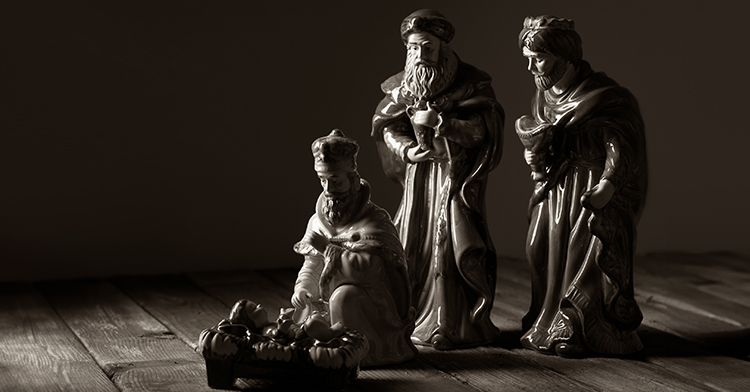When our four children were young, my husband and I looked for ways to embody a Christian mindset about the place of material goods in the life of our family.
We bought used strollers, Onesies and puzzles. We did not let our children watch TV, and we encouraged activities such as reading, crafts, music making and playing outside rather than playing with plastic toys equipped with batteries or sirens. But we were stumped by Christmas gift giving.
We didn’t have much money, but we knew that piles of gifts under the tree spawned by endless commercials beckoning us to the mall were not what we would want to endorse even if we could afford them.
We wanted to make our Christmas joyful, and to express our love with gifts. But we found that we needed a set of Christian guidelines -- which we craved in so much of parenting -- for this special day.
So we experimented. We decided early on not to do Santa. So one year we gave each child only a card from Heifer International stating that an animal had been given to a needy family in his or her name. That was not our merriest Christmas. (Our family loves Heifer -- we have volunteered for Heifer for years -- but it’s hard for even the most altruistic of children to get excited about an envelope.)
Another year we decided we would make gifts for one another. Again, not the greatest idea -- some of us are craftier than others. And how many oatmeal-box drum sets does a child need? Then we tried giving only fair-trade merchandise. My girls and I still love to do this, but the boys have yet to find a fair-trade NERF-Lego-remote-control-transformer gizmo with the impact that they crave on Christmas morning.
Then, at a retreat on Christian life, I heard Susan V. Vogt describe a wonderful tradition suggested in her book “Raising Kids Who Will Make a Difference: Helping Your Family Live with Integrity, Value, Simplicity, and Care for Others.” A parent of four kids herself and a counselor and family life educator, she had tried her own experiments with gift giving, eventually settling on a simple yet elegant plan: she and her husband give each of their children only three gifts for Christmas -- a “heart’s desire,” a piece of clothing and “something to grow on.”
I liked her idea immediately. Giving these gifts would ensure that the needs and wants of each child would be met, that each would receive an equal number of gifts, and that we would have a structure to help us resist the cultural message to run out and buy.
My husband and I adopted this practice, and it has worked well for us for more than 10 years. Our kids -- now 20, 18, 13 and 11 -- tell us their heart’s-desire choice and what piece of clothing they need, and we come up with their something-to-grow-on. We each draw a name and are responsible for putting three additional small items in one person’s stocking. My husband and I exchange one gift, and the children buy or make a present for us if they wish.
We do put some restrictions on the heart’s-desire gift (no BB guns), but the kids mostly end up content. This year, for instance, our 13-year-old is getting a book on empires for his heart’s-desire, a new winter coat for his something-to-wear and a nice chess set for his something-to-grow-on.
While he has already exclaimed, “Only three gifts again? That’s really cheap, Mom!” I know he is simply parroting what his middle school friends will say to him. On Christmas morning, he will be both happy and satisfied.
It makes sense. If you identify the gift you really want, you’ll be satisfied. One interesting phenomenon is that our children’s heart’s-desire gifts are often much smaller than what we might have chosen for them; this year our 11-year-old has asked for a small bag of Lego accessories costing $10. And after you are satisfied, how could you need more?
This is a fairly countercultural idea, and I confess that we are far from perfect. We still struggle with the human tendency to want more than we need. Our family accumulates enough stuff in our house to necessitate multiple drop-offs at the Goodwill every year, and our younger son simply runs to his buddy Connor’s house to play with all the electronics that we don’t have.
Giving three gifts to each child is only a modest, line-in-the-sand Christian response to a society gone crazy with spending and getting, even in hard economic times, and even in a world where most children receive no gifts at all.
I freely admit that what my husband and I began as a discipline for our young children has more recently become a helpful mindset for us as well. Now that we can afford to purchase more for our kids, it has become tempting to give more. But the structure of three gifts holds back our desires, too, as it forces us to ask what our kids really need to receive, what we really need to give, and who might need that money more.
This December, for example, I am struggling mightily with the impulse to walk into an overpriced teenage-girl store and buy my daughters pretty dresses and jewelry that I know would delight them, make them love me more, and probably land them important jobs and brilliant spouses. (I confess that I don’t wrestle with the same desire to purchase a NERF N-Strike Maverick Blaster.)
But the practice of three gifts gives me the discipline to curb these irrational spending desires. It reminds my husband and me -- even more than the kids, who are used to the three-gift rule -- when enough is enough.
Gift giving can be a good thing. It is a wonderful way of showing our love for one another. But we need to watch how that loving desire to please our family and friends is exploited by companies that vie for our money, and how it distracts from the waiting postures of Advent.
The giving of three gifts in our house precedes the season of Epiphany, when the magi offer three gifts at the feet of the Christ child. Their three gifts were abundant, extravagant and enough for this simple holy child in a manger. These gifts and God’s gift of the Christ child remind us of what we know but find so hard to live out -- that more is not better in the Christmas season.









